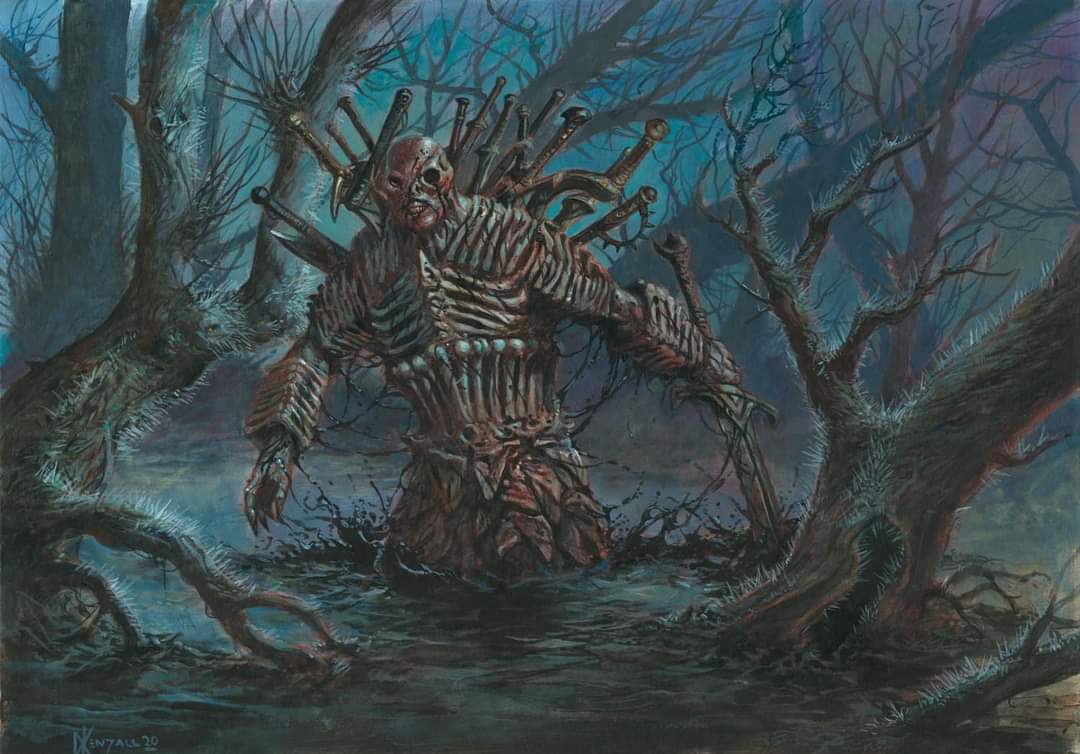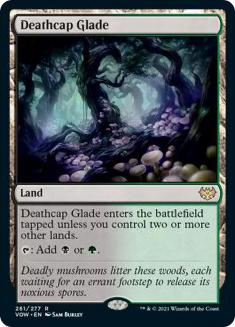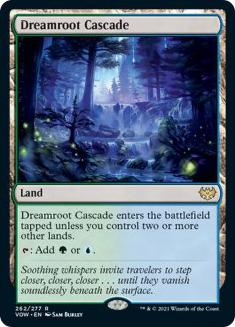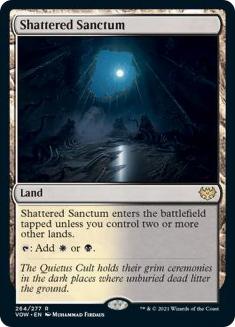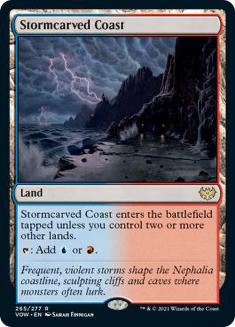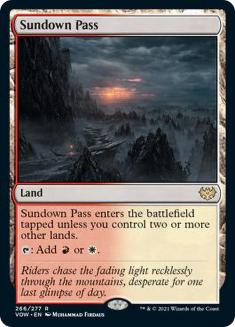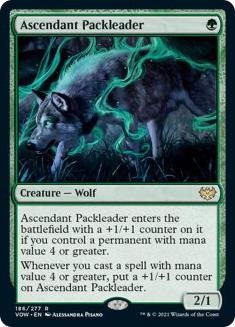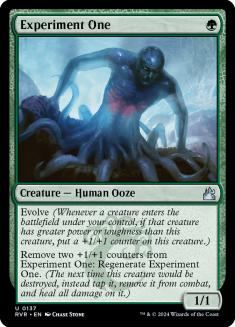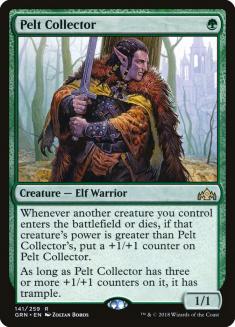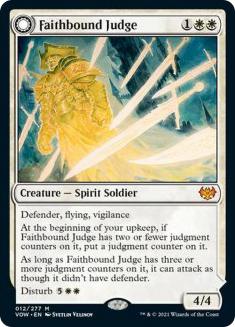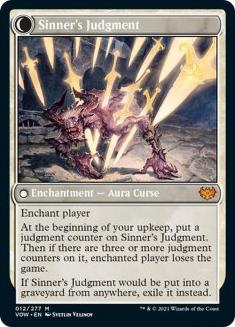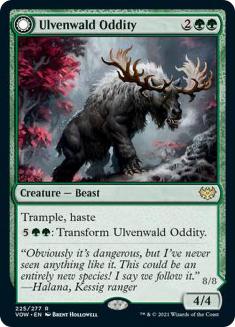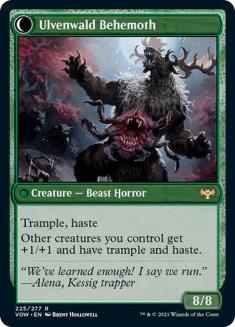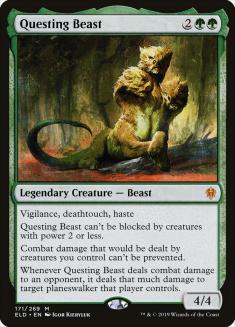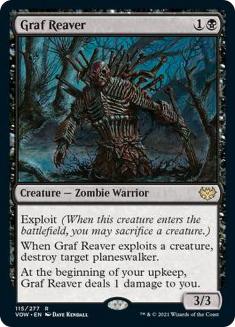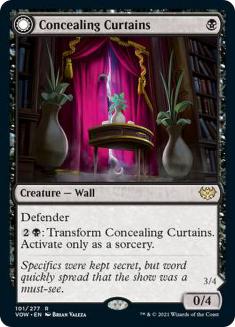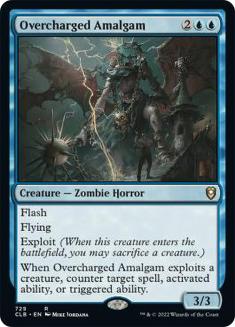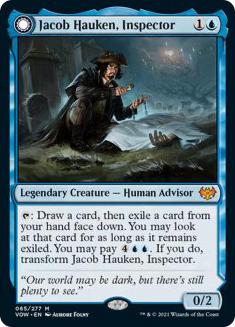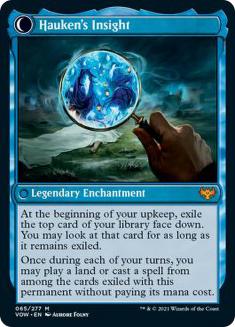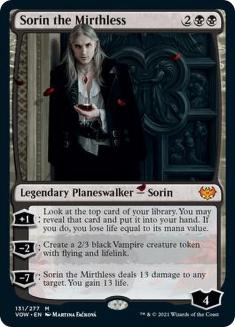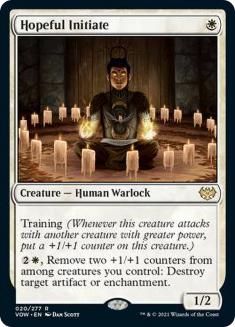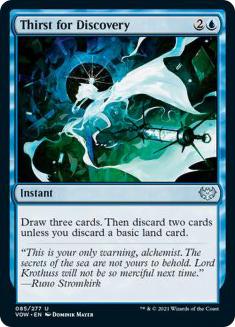Part 2 of the Innistrad Double Feature is here, and I’m here to break down my Top 10 Cube picks from Innistrad: Crimson Vow. Innistrad: Midnight Hunt was chock-full of Cube goodies, and Innistrad: Crimson Vow looks like a fitting follow-up. I would expect nothing less, seeing as we are living in the golden age of Cube Draft, after all.
Thematically, Innistrad: Crimson Vow is incredibly similar to Innistrad: Midnight Hunt, so I’ll spare you my rehashing of the set’s themes and sub in a link to my Innistrad: Midnight Hunt Top 10 article. The major innovation in Innistrad: Crimson Vow that I was excited for early in preview season was the introduction of Blood tokens; that said, it looks like none of the cards that generate these tokens were terribly pushed. This is understandable considering that cheap looting and artifact tokens are both exploitable independently. Still, I was selfishly hoping to see some bigger risks taken here.
A fairly significant development from the set is the completion of the dual land cycle started in Innistrad: Midnight Hunt. You never know if they’re going to round out a land cycle these days. After playing with the first five slowlands a bit in the Magic Online (MTGO) Vintage Cube, I’m convinced that they’re a great fit for 540-card Cubes. I like them less than fastlands but I think there’s a real argument that they’re an improvement on the Drowned Catacomb-style duals in many Cubes.
Realistically, these lands will make more Cubes than many of the cards in my Top 10 list. I find it boring to put lands that only fix mana on such lists, though. I want to talk about the sweet spells! So let’s get to it, shall we?
10. Ascendant Packleader
Ascendant Packleader has a lot of text that doesn’t amount to much. The long and short of it is that it’s a 2/1 for G, which is a significant downgrade from Hexdrinker but a big step in allowing green to get away from mana acceleration in Cube and opening up more space for green as an aggressive color. Wolf can be a relevant creature type and the card has some scalability, but I’m not singing either’s praises.
I’m really just happy to see a green one-drop that increases the appeal of Experiment One and Pelt Collector and in doing so offers more reason to move away from Llanowar Elves. Ascendant Packleader won’t make its way into higher-powered Cubes with mana ramp being the whole of green’s strength in those environments; still, I’m happy to see the card for Cube broadly. I hope to see more aggressive green creatures like this with palatable casting costs in the future.
9. Faithbound Judge
I don’t consider Faithbound Judge to be an especially powerful card, but 4/4s can be difficult to attack through and this design is incredibly cool. Sinner’s Judgment is a really fun upside to put on the card and is an alternate win condition that I fully intend to support in some of my personal Cubes.
I would not expect Faithbound Judge to perform exceptionally in environments like the MTGO Vintage Cube. It’s fun and functional enough in Azorius-based decks that I wouldn’t be apposed to its inclusion, though. In truth, I’d probably go out of my way to try to get some wins with Sinner’s Judgment.
Faithbound Judge is one of those cards that isn’t quite there for high-powered Cubes. In other environments, it presents a frustrating roadblock against aggressive decks. There’s definitely a sweet spot to be found somewhere in-between. At the very least, it’s a shoo-in for the original Twobert.
8. Ulvenwald Oddity
Ulvenwald Oddity is another green creature that just attacks and blocks, but unlike Ascendant Packleader I expect the card to have more broad appeal. The conversation around the card has been that it’s a worse Questing Beast considering that it has three fewer chapters of text, but in terms of Cube Draft I would argue that the Oddity is a massive upgrade.
Vigilance and the rest are all well and good, but in high-powered Cubes this amounts to some extra text on a 4/4 in a color that’s generally trying to go much bigger. Situationally, Questing Beast does enough stuff that I won’t say that Ulvenwald Oddity is a strict upgrade. When you consider that it’s in a color that’s trying to Craterhoof Behemoth every game if possible, though, my position starts to make sense. The mana sink to upgrade the body coupled with the ability to turn your mana creatures and cards like Deranged Hermit into real threats is much more valuable to Gaea’s Cradle decks than an evasive 4/4.
The past couple years have delivered a massive improvement to four-mana green cards for Cube. I would put Ulvenwald Oddity near the top of the list, easily over Questing Beast.
7. Graf Reaver
Exploit is a fun and powerful mechanic, and I’m happy to see it return in Innistrad: Crimson Vow. Remember that creatures with exploit can just sacrifice themselves, which makes them sort of modal cards. In that sense, Graf Reaver is your choice of a 3/3 for 1B with some downside or a clean answer to a planeswalker, with the occasional option to sacrifice a different creature and get both.
These options aren’t thrilling, but the modality is, especially with Zombie and Warrior both offering a lot of tribal support if you’re into that sort of thing. With black not seeing much aggressive support in the MTGO Cubes I don’t think we’ll be seeing this in Vintage Cube, but it’s a very good fit for formats like the Arena Cubes.
6. Concealing Curtains
A way that I differ from Booster Draft enthusiasts is that I generally cannot muster any excitement for 0/4 creatures. I’m just not a Kraken Hatchling guy. I am, however, very in favor of more Cubeable cheap creatures that offer some interaction and evasion. Concealing Curtains is kind of a weird one, because it’s really more of a three- or four-drop than a one-drop. Iif you’re playing a deck that’s remotely interested in casting creature spells, though, then it will minimally demand a good removal spell.
Putting Concealing Curtains in a controlling deck is a pretty easy sell for me, and the menace on Revealing Eye is inviting for aggressive strategies as well. I’m most interested in the card for combo decks though (specifically Reanimator). It’s not uncommon to find yourself in a spot playing a Reanimator deck where your opponent is obviously leaving up some kind of interaction and it’s not wise for you to move in on your combo. Concealing Curtains offers additional strength for these decks in those positions and makes for a solid threat in its own right.
Concealing Curtains is just solid for a more midrange environment. Its use in Reanimator strategies puts it over as a broadly powerful Cube consideration for me.
5. Overcharged Amalgam
I mentioned that creatures with exploit are more or less modal cards, and Overcharged Amalgam is lousy with modes! The exploit ability gives you all of the options of Disallow, but it’s also worth noting that “four-mana 3/3 flash flyer” is a solid mode in its own right.
You’re paying a lot for the ability if Overcharged Amalgam has to exploit itself. Even so, the fact that it offers a body that’s good for blocking and/or pressuring planeswalkers/opponents makes it a real consideration even for high-powered Cubes. I’m also just generally into cards that ask players to put creatures in their blue decks. Overcharged Amalgam is an awesome option for Cubes broadly.
4. Jacob Hauken, Inspector
Two-mana looters have a long history of being Cube staples, so it shouldn’t be terribly surprising to see Jacob Hauken, Inspector on my list. There are some relevant differences between Jacob and Merfolk Looter that cut both ways that are worth discussing though.
For starters, it will often be the case that you want cards in your graveyard. Whether we’re talking about delving, reanimating, or myriad other graveyard synergies, there are lots of reasons to dislike that Jacob exiles the cards that you loot. That said, an active looter at the accepted rate makes plenty of decks with little or no intention of using the graveyard. Card filtering is just a powerful thing to have access to. What’s arguably less important, considering the cost and vulnerability, is that Hauken’s Insight is bonkers if you can transform the card.
Is that a pipe dream? Maybe. But how bad is that relative to the general threat of any other looter just dying the turn you cast it anyway? It’s also cool to have big aspirations. This is a dream that I’m interested in living and that I endorse.
3. Sorin the Mirthless
Have you ever noticed how every four-mana black planeswalker is incredibly specific and pretty bad in most Cubes? This historical fact, coupled with how tame recent planeswalker designs have been, left me a bit shocked to see Sorin the Mirthless released as printed. I don’t think that the design is egregiously powerful or anything; it’s just a pleasant surprise is all.
Sorin plusses for card advantage, minuses to protect itself in a way that generates card advantage, and has an ultimate that does most of the work in closing a game. What’s not to like? Okay, the one thing I don’t like is that you can decline to add the card to your hand and take the damage with the [+1], but it’s probably good to give cowardly players the option to decline.
Sorin isn’t exciting if we’re talking about Vintage Cube and the company of the most powerful cards ever printed, but it also isn’t bad. At 540 cards, the MTGO Vintage Cube does have a bit of a problem historically with a number of the black cards actually being bad. While I don’t consider Sorin an absolute must-include, I do believe it to be a very strong consideration for Cube broadly.
2. Hopeful Initiate
Stop me if you’ve heard this one before, but I think that this one-mana threat with relevant creature types that scales as it attacks is powerful. Starting at one power and needing to attack to grow are both downsides, but if you’re making good attacks at all, then the immediate bump to 2/3 the first time you train Hopeful Initiate should make the card well worth the price of admission.
I don’t think that the ability to destroy artifacts and enchantments is all that relevant, but “incidentally” is the way that I prefer my Disenchants to come anyway. You’re not paying any extra mana for the ability being printed on the card and sometimes you’ll be happy that it’s there.
I find it difficult to argue against Hopeful Initiate’s inclusion in any Cube that could feature it with a supported white aggressive deck. That tends to be most of them. From Vintage Cube to Arena Cube, this card is just an out-and-out Cube staple.
1. Thirst for Discovery
A new spin on an old classic, Thirst for Discovery adds a minor downgrade to Compulsive Research along with a major upgrade. If you want to only discard one card it has to be a basic land, but the inability to discard nonbasics is minor when coupled with the bump from sorcery to instant.
Thirst for Knowledge, and more recently Thirst for Meaning, have offered this card selection at instant speed for years, but it’s so much easier to have an abundance of expendable basic lands in a deck than artifacts or enchantments. This might not seem like a big deal to everyone, but if you were around when Thirst for Knowledge was restricted in Vintage, you’re likely as excited as I am to start Cubing with Thirst for Discovery.
I’m loving the look of Innistrad: Crimson Vow for Cube. The only negative about the set that I could offer is that a lot of the more powerful designs for Cube are blue, which is the color that needs the least help. We blue players will take it, but I’m just saying.
More notably, red was completely absent from my Top 10 list. There are several red cards that I will personally be Cubing with, but the power in red is mostly locked up in expensive creatures with too much competition in similar cards to realistically make waves. I like Manaform Hellkite and Volatile Arsonist; it’s just not difficult to come up with more powerful cards for the same cost. Cemetery Gatekeeper, Kessig Wolfrider, and Voltaic Visionary all made my long list, but realistically they’re closer to fine than great. Reckless Impulse is maybe the card in the set that’s closest to breaking the mold, but it’s both a little too random and a little too inefficient. Chandra, Dressed to Kill is similarly safe and unexciting for Cube.
Even still, I’m excited to get my hands on every card in my Top 10 and generally to see more from my favorite plane. Happy Cubing, gamers.

